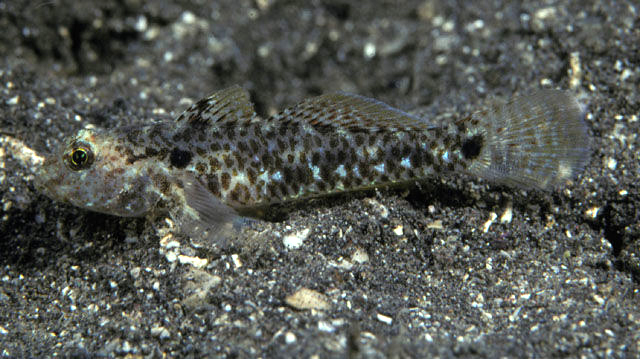Sidespot Sandgoby, Fusigobius humeralis (Randall 2001)
Other Names: Shoulderspot Sandgoby

A Sidespot Sandgoby, Fusigobius humeralis, at Bali, Indonesia. Source: John E. Randall / FishBase. License: CC by Attribution-NonCommercial
Summary:
A semi-transparent goby with a prominent pupil-sized black spot above the pectoral-fin base, another black spot on the middle of the caudal-fin base, and numerous small dusky orange-yellow spots on the side, with those on head forming oblique rows.
Cite this page as:
Bray, D.J. 2023, Fusigobius humeralis in Fishes of Australia, accessed 02 Jul 2025, https://fishesofaustralia.net.au/home/species/123
Sidespot Sandgoby, Fusigobius humeralis (Randall 2001)
More Info
|
Distribution |
In the Australian EEZ, recorded from Hibernia Reef in the Timor Sea, and the far northern Great Barrier Reef, Queensland; also at Cocos (Keeling) Islands and Christmas Island in the eastern Indian Ocean. Elsewhere the species occurs in the tropical, Indo-west Pacific. Inhabits mixed sandy & rubble areas near reefs at depths to 30 m. |
|
Features |
Dorsal fin VI + I, 9; Anal fin I, 8; Pectoral fin 17-19; Longitudinal scale series 24-25; Vertebrae 26. Body depth 4.4-4.8 in SL; snout short, 3.4-3.7 in SL; posterior nostril near edge of orbit; sensory canals and pores present on head (2 lateral pores above preopercle); reduced sensory-papillae rows on cheek. Head naked except for scales on side of nape reaching nearly to orbit. First dorsal fin not higher than second (longest soft dorsal-fin ray longer than longest dorsal-fin spine); second or third dorsal-fin spine longest, 5.35-5.8 in SL. Pelvic fins disc-like, fully united medially by membrane; pelvic frenum present. |
|
Colour |
Body translucent with numerous small dusky orange-yellow spots on head and body, those on head in oblique rows; a round black spot as large or larger than pupil in humeral region just above base of pectoral fin, and a second black spot of about the same size at mid base of caudal fin. |
|
Etymology |
The specific name is from the Latin humeralis (= of the forelimb) in reference to the distinctive black spot on the shoulder (humeral) region. |
|
Species Citation |
Coryphopterus humeralis Randall, 2001, Zoological Studies 40(3): 212, figs 5, 6. Type locality: Embudu Island, southern side, South Malé Atoll, Republic of Maldives, western Indian Ocean, depth 8-10 m. |
|
Author |
Bray, D.J. 2023 |
|
Resources |
Sidespot Sandgoby, Fusigobius humeralis (Randall 2001)
References
Allen, G.R. & Erdmann, M.V. 2012.Reef fishes of the East Indies. Perth : Tropical Reef Research 3 vols, 1260 pp.
Munroe, T.A. & Greenfield, D. 2016. Fusigobius humeralis. The IUCN Red List of Threatened Species 2016: e.T193230A2212076. http://dx.doi.org/10.2305/IUCN.UK.2016-3.RLTS.T193230A2212076.en. Downloaded on 10 January 2019.
Randall, J.E. 2001. Five new Indo-Pacific gobiid fishes of the genus Coryphopterus. Zoological Studies 40(3): 206-225 (as Coryphopterus humeralis) See ref online
Randall, J.E. 2005. Reef and shore fishes of the South Pacific. New Caledonia to Tahiti and the Pitcairn Islands.University of Hawaii Press, Honolulu, Hawaii. 720 pp. (as Coryphopterus humeralis)



